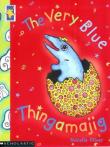AustLit
The material on this page is available to AustLit subscribers. If you are a subscriber or are from a subscribing organisation, please log in to gain full access. To explore options for subscribing to this unique teaching, research, and publishing resource for Australian culture and storytelling, please contact us or find out more.
Latest Issues
AbstractHistoryArchive Description
The Very Blue Thingamajig hatches from an egg one day, but compared with the other thingamajigs, he is very plain. Then one morning he wakes up with a twisty, twirly tail, and every morning after that he wakes up with a new feature.
Publication Details of Only Known VersionEarliest 2 Known Versions of
Works about this Work
-
The Art of Narelle Oliver
Joy Lawn
(interviewer),
2009
single work
interview
— Appears in: Magpies: Talking About Books for Children , September vol. 24 no. 4 2009; (p. 4-6) In response to Lawn's questions regarding her artistic vision, innovative techniques and interest in natural Australian history, Oliver says her work is created through the 'intriguing relationship between words and pictures' and how 'they work either together or against each other as different points of view in a narrative' (4). Lawn asks Oliver about her 'vision and vocation' which, through her strong artistic style and celebratory designs of Australian indigenous animals, produces texts that are a 'melding of non-fiction and fiction' (5). Oliver says she has been fascinated by indigenous adaptations of Australian native animals since early childhood and this interest developed further when she studied biology. With her first picture book, Leaf Tail she wanted to introduce young readers to 'some of the less-well-known Australian creatures' but 'did not want to write a straight information book' (5). Instead, she wanted to explore the creative potential of the adaptive features to be found among many creatures - design, shape, texture and pattern - in terms of storytelling and 'problem-solution scenarios' (5). Oliver has also produced picture books about imaginary and mythological creatures, for example, Mermaids Most Amazing, The Very Blue Thingamajig, and Dancing the Boom-cha-cha Boogie, however, it is mainly through her natural history picture books that she aims to capture the diversity of Australia's natural landscapes and 'instil postive feelings about these places in young Australian readers' (6). In this sense, her work is driven by the belief that 'a personal feeling and knowledge of the landscape is critical to developing a desire to preserve that landscape' (6). -
Untitled
2003
single work
review
— Appears in: Reading Time : The Journal of the Children's Book Council of Australia , May vol. 47 no. 2 2003; (p. 29)
— Review of The Very Blue Thingamajig 2003 single work picture book -
Untitled
2003
single work
review
— Appears in: Magpies : Talking About Books for Children , March vol. 18 no. 1 2003; (p. 27-28)
— Review of The Very Blue Thingamajig 2003 single work picture book
-
Untitled
2003
single work
review
— Appears in: Magpies : Talking About Books for Children , March vol. 18 no. 1 2003; (p. 27-28)
— Review of The Very Blue Thingamajig 2003 single work picture book -
Untitled
2003
single work
review
— Appears in: Reading Time : The Journal of the Children's Book Council of Australia , May vol. 47 no. 2 2003; (p. 29)
— Review of The Very Blue Thingamajig 2003 single work picture book -
The Art of Narelle Oliver
Joy Lawn
(interviewer),
2009
single work
interview
— Appears in: Magpies: Talking About Books for Children , September vol. 24 no. 4 2009; (p. 4-6) In response to Lawn's questions regarding her artistic vision, innovative techniques and interest in natural Australian history, Oliver says her work is created through the 'intriguing relationship between words and pictures' and how 'they work either together or against each other as different points of view in a narrative' (4). Lawn asks Oliver about her 'vision and vocation' which, through her strong artistic style and celebratory designs of Australian indigenous animals, produces texts that are a 'melding of non-fiction and fiction' (5). Oliver says she has been fascinated by indigenous adaptations of Australian native animals since early childhood and this interest developed further when she studied biology. With her first picture book, Leaf Tail she wanted to introduce young readers to 'some of the less-well-known Australian creatures' but 'did not want to write a straight information book' (5). Instead, she wanted to explore the creative potential of the adaptive features to be found among many creatures - design, shape, texture and pattern - in terms of storytelling and 'problem-solution scenarios' (5). Oliver has also produced picture books about imaginary and mythological creatures, for example, Mermaids Most Amazing, The Very Blue Thingamajig, and Dancing the Boom-cha-cha Boogie, however, it is mainly through her natural history picture books that she aims to capture the diversity of Australia's natural landscapes and 'instil postive feelings about these places in young Australian readers' (6). In this sense, her work is driven by the belief that 'a personal feeling and knowledge of the landscape is critical to developing a desire to preserve that landscape' (6).
Awards
- 2003 winner BILBY (Books I Love Best Yearly) Awards — Early Readers
Last amended 11 Aug 2017 08:58:07
Export this record






